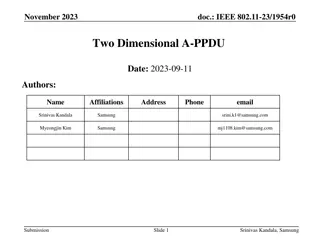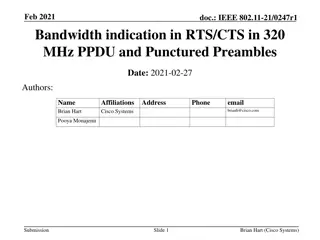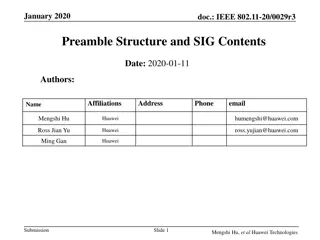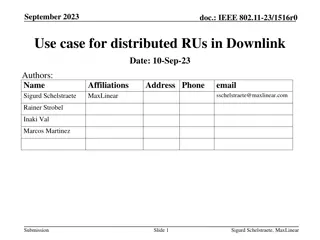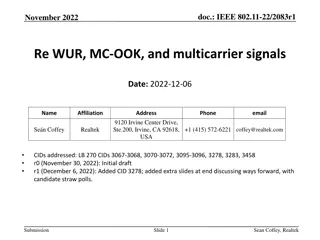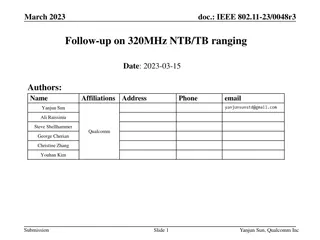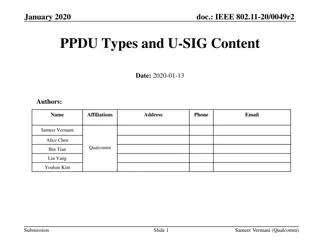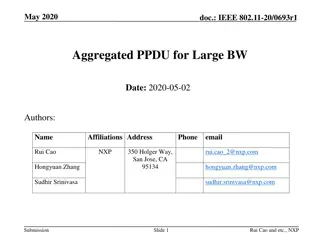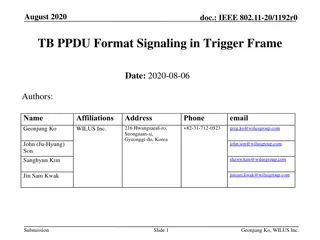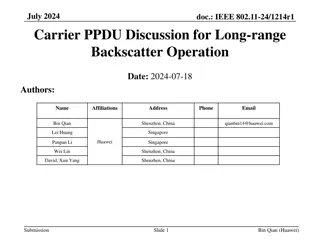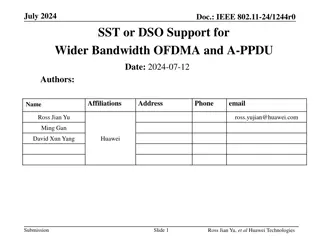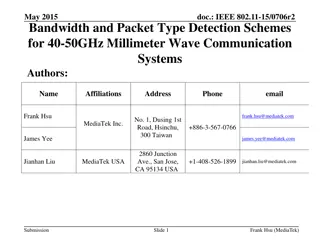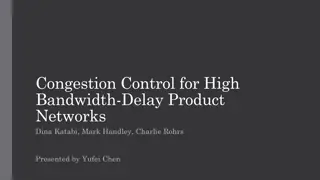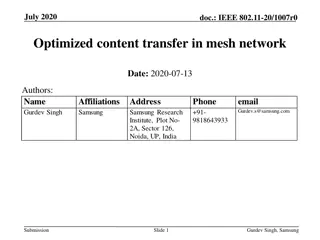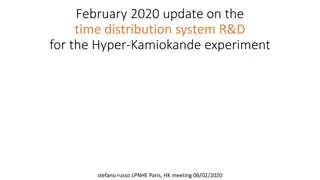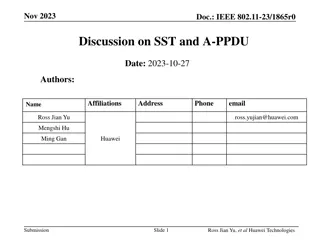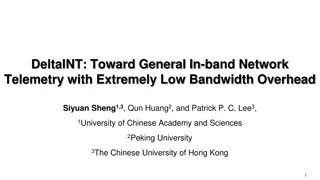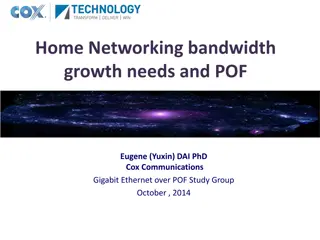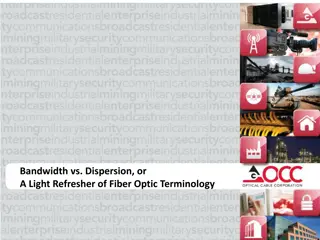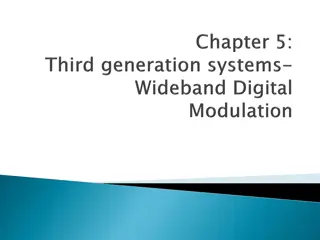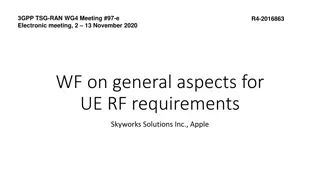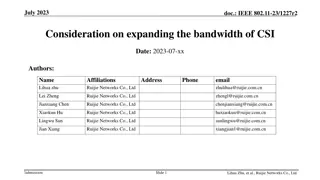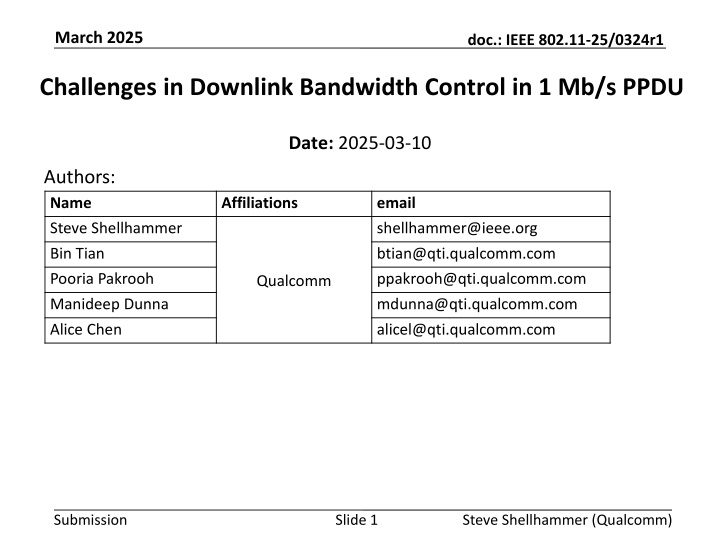
Challenges in Downlink Bandwidth Control for 1 Mb/s PPDU
Explore the challenges in managing downlink bandwidth for 1 Mb/s PPDU in IEEE 802.11 networks, considering regulations, OFDM symbols, and Barker codes. Discover insights on optimizing bandwidth control in wireless communication technology.
Download Presentation

Please find below an Image/Link to download the presentation.
The content on the website is provided AS IS for your information and personal use only. It may not be sold, licensed, or shared on other websites without obtaining consent from the author. If you encounter any issues during the download, it is possible that the publisher has removed the file from their server.
You are allowed to download the files provided on this website for personal or commercial use, subject to the condition that they are used lawfully. All files are the property of their respective owners.
The content on the website is provided AS IS for your information and personal use only. It may not be sold, licensed, or shared on other websites without obtaining consent from the author.
E N D
Presentation Transcript
March 2025 doc.: IEEE 802.11-25/0324r1 Challenges in Downlink Bandwidth Control in 1 Mb/s PPDU Date: 2025-03-10 Authors: Name Affiliations email Steve Shellhammer shellhammer@ieee.org Bin Tian Pooria Pakrooh btian@qti.qualcomm.com ppakrooh@qti.qualcomm.com Qualcomm Manideep Dunna mdunna@qti.qualcomm.com Alice Chen alicel@qti.qualcomm.com Submission Slide 1 Steve Shellhammer (Qualcomm)
March 2025 doc.: IEEE 802.11-25/0324r1 Background The Downlink supports two data rates o 1 Mb/s o 250 kb/s The Downlink uses OOK The Downlink Data field uses Manchester encoding Hence the OOK symbol duration in the Data field is 0.5 s Based on ETSI and China regulations it is beneficial to have wider bandwidth in the Downlink to allow for higher transmit power in those regulatory domains Submission Slide 2 Steve Shellhammer (Qualcomm)
March 2025 doc.: IEEE 802.11-25/0324r1 ETSI and China Regulations From [1] we see the ETSI and China 2.4 GHz regulations Region Power Limit (dBm) PSD Limit (dBm/MHz) ETSI 20 10 China 20 10 The PSD limit is measured in 1 MHz bandwidth So, the highest power in any 1 MHz bandwidth controls the total allowed transmit power Submission Slide 3 Steve Shellhammer (Qualcomm)
March 2025 doc.: IEEE 802.11-25/0324r1 Challenges in using OFDM Symbol for Bandwidth Control Several previous presentations have looked at some of the challenges in generation a wideband Downlink 1 Mb/s PPDU In [2, 3, 4] it was pointed out that for a 20 MHz OFDM symbol with duration of 0.5 s, only a few (e.g., 8) subcarriers can be used In [3] it was pointed out that Because of the small IFFT size, the variations in PSD will reduce the total allowed power in case of PSD limited transmission, as the PSD is measured over 1 MHz o They suggested that To reduce these variations, randomization in frequency may be used Submission Slide 4 Steve Shellhammer (Qualcomm)
March 2025 doc.: IEEE 802.11-25/0324r1 Challenges with using a Barker Code for Bandwidth Control In [4] they showed the use of a Barker code (like in DSSS) for the 250 kb/s Downlink However, if we want to use a Barker code for 0.5 us OOK symbols, there are some challenges First, if we were to use an 11-bit Barker code, like in DSSS, the bandwidth would be 44 MHz, and not 22 MHz o This is because the 0.5 s symbol is half the duration of the 1 s symbol used in DSSS Another approach is to use a shorter Barker code, but that does not reuse the DSSS design Submission Slide 5 Steve Shellhammer (Qualcomm)
March 2025 doc.: IEEE 802.11-25/0324r1 Challenges with using a Barker Code for Bandwidth Control One possibility is to use a 5-bit Barker code for spreading the 0.5 s OOK symbols The 5-bit Barker code is [1,1,1, 1,1] We try that code and apply it to a zero-mean OOK sequence We plot the PSD of the unfiltered and filtered spread sequence We also show the DSSS Spectral mask Submission Slide 6 Steve Shellhammer (Qualcomm)
March 2025 doc.: IEEE 802.11-25/0324r1 Challenges with using a Barker Code for Bandwidth Control We see with some filtering the PSD fits within the DSSS spectral mask However, the PSD is not very flat, which will lead to a loss in transmit power based on PSD regulatory limits Submission Slide 7 Steve Shellhammer (Qualcomm)
March 2025 doc.: IEEE 802.11-25/0324r1 Conclusions There are benefits in a wideband Downlink in ETSI and China regulatory domains, since it allows higher transmit power However, widening the bandwidth using a 0.5 s OFDM symbol has challenges, as identified in several presentations Also, widening the bandwidth using a 5-bit Barker sequence does not provide a flat PSD, which also limits the allowed transmit power Submission Slide 8 Steve Shellhammer (Qualcomm)
March 2025 doc.: IEEE 802.11-25/0324r1 References 1. Steve Shellhammer and Bin Tian, Regulations and Noise Figure Impact on SNR, IEEE 802.11-17/365r0, March 2017 2. Wang Ke, Shengjing Cui, Weijie Xu, OOK generation for AMP DL, IEEE 802.11-24/1802r0, November 2024 3. Leif Wilhelmsson, Sebastian Max, and Dennis Sundman, Signal Design for OOK, IEEE 802.11-25/51r0, January 2025 4. Panpan Li, Bin Qian, and Lei Huang, AMP DL Wideband OOK Generation, IEEE 802.11-25/50r0, January 2025 Submission Slide 9 Steve Shellhammer (Qualcomm)

